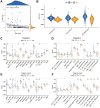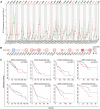Molecular characterization of Golgi apparatus-related genes indicates prognosis and immune infiltration in osteosarcoma
- PMID: 38460960
- PMCID: PMC11006476
- DOI: 10.18632/aging.205645
Molecular characterization of Golgi apparatus-related genes indicates prognosis and immune infiltration in osteosarcoma
Abstract
Background: The Golgi apparatus (GA) is crucial for protein synthesis and modification, and regulates various cellular processes. Dysregulation of GA can lead to pathological conditions like neoplastic growth. GA-related genes (GARGs) mutations are commonly found in cancer, contributing to tumor metastasis. However, the expression and prognostic significance of GARGs in osteosarcoma are yet to be understood.
Methods: Gene expression and clinical data of osteosarcoma patients were obtained from the TARGET and GEO databases. A consensus clustering analysis identified distinct molecular subtypes based on GARGs. Discrepancies in biological processes and immunological features among the subtypes were explored using GSVA, ssGSEA, and Metascape analysis. A GARGs signature was constructed using Cox regression. The prognostic value of the GARGs signature in osteosarcoma was evaluated using Kaplan-Meier curves and a nomogram.
Results: Two GARG subtypes were identified, with Cluster A showing better prognosis, immunogenicity, and immune cell infiltration than Cluster B. A novel risk model of 3 GARGs was established using the TARGET dataset and validated with independent datasets. High-risk patients had poorer overall survival, and the GARGs signature independently predicted osteosarcoma prognosis. Combining risk scores and clinical characteristics in a nomogram improved prediction performance. Additionally, we discovered Stanniocalcin-2 (STC2) as a significant prognostic gene highly expressed in osteosarcoma and potential disease biomarker.
Conclusions: Our study revealed that patients with osteosarcoma can be divided into two GARGs subgroups. Furthermore, we have developed a GARGs prognostic signature that can accurately forecast the prognosis of osteosarcoma patients.
Keywords: Golgi apparatus; biomarkers; immune infiltration; osteosarcoma; prognosis.
Conflict of interest statement
Figures








Similar articles
-
Molecular subtype identification and signature construction based on Golgi apparatus-related genes for better prediction prognosis and immunotherapy response in hepatocellular carcinoma.Front Immunol. 2023 Mar 27;14:1113455. doi: 10.3389/fimmu.2023.1113455. eCollection 2023. Front Immunol. 2023. PMID: 37051238 Free PMC article.
-
Molecular subtype identification and prognosis stratification based on golgi apparatus-related genes in head and neck squamous cell carcinoma.BMC Med Genomics. 2024 Feb 16;17(1):53. doi: 10.1186/s12920-024-01823-9. BMC Med Genomics. 2024. PMID: 38365684 Free PMC article.
-
Establishment of Golgi apparatus-related genes signature to predict the prognosis and immunotherapy response in gastric cancer patients.Medicine (Baltimore). 2024 Mar 15;103(11):e37439. doi: 10.1097/MD.0000000000037439. Medicine (Baltimore). 2024. PMID: 38489711 Free PMC article.
-
Development and validation of apoptosis-related signature and molecular subtype to improve prognosis prediction in osteosarcoma patients.J Clin Lab Anal. 2022 Jul;36(7):e24501. doi: 10.1002/jcla.24501. Epub 2022 May 16. J Clin Lab Anal. 2022. PMID: 35576501 Free PMC article.
-
Signature constructed by glycolysis-immune-related genes can predict the prognosis of osteosarcoma patients.Invest New Drugs. 2022 Aug;40(4):818-830. doi: 10.1007/s10637-022-01228-4. Epub 2022 Apr 18. Invest New Drugs. 2022. PMID: 35435626 Review.
Cited by
-
Exploratory Analysis of Molecular Subtypes in Early-Stage Osteosarcoma: Identifying Resistance and Optimizing Therapy.Cancers (Basel). 2025 May 16;17(10):1677. doi: 10.3390/cancers17101677. Cancers (Basel). 2025. PMID: 40427174 Free PMC article.
-
Prognostic and immunological characterization of osteosarcoma patients evaluated by liquid-liquid phase separation related genes.Discov Oncol. 2025 May 30;16(1):958. doi: 10.1007/s12672-025-02769-9. Discov Oncol. 2025. PMID: 40445434 Free PMC article.
References
-
- Kelley LM, Schlegel M, Hecker-Nolting S, Kevric M, Haller B, Rössig C, Reichardt P, Kager L, Kühne T, Gosheger G, Windhager R, Specht K, Rechl H, et al.. Pathological Fracture and Prognosis of High-Grade Osteosarcoma of the Extremities: An Analysis of 2,847 Consecutive Cooperative Osteosarcoma Study Group (COSS) Patients. J Clin Oncol. 2020; 38:823–33. 10.1200/JCO.19.00827 - DOI - PubMed
-
- Smeland S, Bielack SS, Whelan J, Bernstein M, Hogendoorn P, Krailo MD, Gorlick R, Janeway KA, Ingleby FC, Anninga J, Antal I, Arndt C, Brown KLB, et al.. Survival and prognosis with osteosarcoma: outcomes in more than 2000 patients in the EURAMOS-1 (European and American Osteosarcoma Study) cohort. Eur J Cancer. 2019; 109:36–50. 10.1016/j.ejca.2018.11.027 - DOI - PMC - PubMed
Publication types
MeSH terms
LinkOut - more resources
Full Text Sources
Medical

